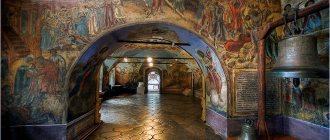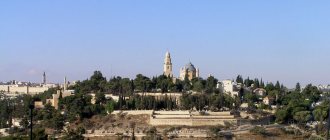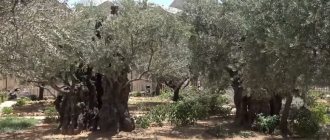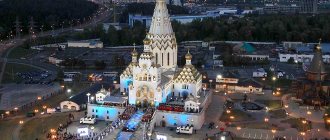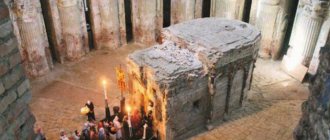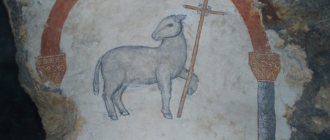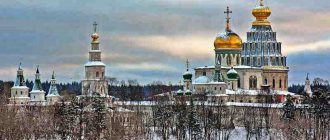The Mount of Olives, stretching from north to south along the eastern wall of the Old City, is an iconic place not only for true Christians, but also for true connoisseurs of ancient history. Being one of the main attractions of Jerusalem and having a close connection with famous biblical events, it attracts thousands of pilgrims from all over the world. Ordinary travelers also love to come here, wanting to see with their own eyes the unsurpassed beauty of this region.
History and current state
In 1870, the head of the Russian Spiritual Mission, Archimandrite Antonin (Kapustin), acquired a plot of land southeast of the site of the Ascension of the Savior at the very top of the Mount of Olives.
During excavations carried out under the leadership of Archimandrite Antonin, the following were discovered:
– under the chapel, at the site of the discovery of the venerable head of St. John the Baptist, there are mosaic floors depicting fish, birds and ornaments, similar to the mosaics of the Monastery of the Cross in Jerusalem and dating back to the 5th, 6th, and 9th centuries; as well as a memorial inscription about a certain “James, the Armenian Bishop of Metzpin”;
– in the so-called “archimandrite’s house” there are mosaic floors of the Byzantine style, possibly earlier than the 6th century;
– in the abbot’s house there is a mosaic with a Greek inscription from the 5th century: “Theodosius, most glorious cuvicularia”;
– numerous burial caves with mosaic decorations.
All this indicated that on the Russian section of the Mount of Olives, in ancient times, there was an extensive and rich necropolis and a number of temples, both Greek and Armenian.
Not far from the place where the head of St. John the Baptist on Olivet there is a stone on which, according to legend, the Mother of God stood during the Ascension to heaven of the Lord Jesus Christ. During the excavations carried out by Father Antonin near this stone, they discovered, as he writes, “a heap of gold mosaics and many pieces of white marble,” as well as the base of two columns, all dating back to the 5th or 6th century A.D., as well as tomb of the hierodeacon of the 6th century. Around this ancient church there once existed a Greek nunnery. During the invasion of the Persian king Khazroes in 614, Jerusalem was destroyed and it is known from history that 1207 murdered people were found on Olivet. The monastery was also destroyed, and the monks suffered martyrdom.
On the site of an ancient Byzantine temple, Father Antonin decided to build a temple in honor of the Ascension of the Lord.
Before the construction of the temple, Father Antonin built a hospice house where Russian pilgrims, usually ascending the Mount of Olives after visiting the cave of Lazarus the Four-Days in Bethany, could stop for rest. Then the pilgrims could admire the panorama of the eastern part of the Judean Desert, the Jordan Valley and the Dead Sea.
In 1871, construction of the temple began. The temple was consecrated only in 1885. Among other reasons for the delay in construction, there was the Russian-Turkish War, during which Father Antonin had to go to Athens.
The temple at that time was called Spaso-Voznesensk at the request of the Jerusalem Patriarchate. Currently, it has returned to its original name.
Along with the church, a 64-meter, 4-tier bell tower was built. It was built by Italian architects.
Upon completion of the construction of the bell tower in 1885, a large bell weighing 308 pounds (4,928 kg), with a diameter of 2 m 13 cm, donated by Father Antonin’s close friend, the Solikamsk merchant Ryazantsov, was delivered to the monastery from Russia.
Within 7 days, the bell, despite many difficulties, was safely delivered (by hand!) from the port to Jaffa. The majestic bell tower of the Russian Church of the Ascension of Olives, the so-called “Russian Candle,” now dominates all the environs of Jerusalem. From its height you can see both the Dead Sea and Transjordan, and with binoculars in clear weather you can see the blue of the Mediterranean Sea.
Finally, despite all the difficulties, on June 7/20, 1886, the solemn consecration of the temple and bell tower took place. Patriarch Nikodim delivered a speech of praise in honor of the builder of the temple, Father Antonin, and his closest assistant, Hieromonk Parthenius.
During the strong earthquake of 1927, Mount Olives was the most damaged. The temple, abbot's house, and the sisters' residential buildings were damaged. During the earthquake, the bell tower swung like a pendulum.
Father Antonin intended to create a monastery here, but Archimandrite Leonid (Sentsov), the new head of the Mission, abandoned this idea because over the past many years there was only one monk Pamvo who had taken root on Olivet and served as a watchman. Therefore, Father Leonid decided to found a convent here.
In 1906, the Olivet Women's Community was approved by the Holy Synod. Hegumen Parthenius was appointed confessor, and the nun Eupraxia (Maria Milovidova), who arrived in Jerusalem in 1880, was appointed abbess. By 1907 there were up to 100 sisters in the community, and by 1914 - 150 sisters.
In 1924, the Olivet community was renamed a monastery, and the nun abbess was elevated to the rank of abbess and given the staff.
With the outbreak of the First World War between Russia and Germany and Turkey, the RDM suffered severe trials. All the clergy of the Mission and all the senior nuns were taken to Egypt. Russian buildings, gardens and farmsteads in Palestine were occupied by Turkish troops. Monastic life on Olivet ceased. The Temple of the Ascension was sealed.
In January 1919, the nuns from Alexandria returned to Olivet, and in June the church was freed from the seals imposed in 1914.
In 1951, Abbess Tamara, daughter of Grand Duke Konstantin Konstantinovich Romanov (poet “K.R.”), was appointed abbess of the monastery. She managed the monastery until 1975. In her presence, in the presence of a representative of King Hussein of Jordan, the 100th anniversary of the RDM was celebrated. She and her sisters survived a fierce firefight during the 1967 Six Day War.
The main problem of the Monastery of Olives was attracting a sufficient number of sisters. Although individual emigrants, as well as sisters from Bessarabia, joined the community, their number was not enough to preserve the Russian appearance of the monastery. In 1930 there were about 300 sisters, then their number gradually decreased, and in the mid-1990s there were about 50 nuns and novices working in the monastery, and the monastery itself at that time was the largest in the ROCOR. Currently, there are 46 nuns in the monastery, among them Russians, Arabs, Romanians, Estonians, Germans and Australians.
On August 29, 2006, the First Hierarch of the ROCOR, Metropolitan Laurus (Shkurla), led the celebrations dedicated to the 100th anniversary of the Ascension Convent on the Holy Mount of Olives. Towards the end of the Divine Liturgy, Patriarch Theophilos III of Jerusalem arrived with members of the Holy Synod of the Patriarchate of Jerusalem and the Holy Sepulcher Brotherhood.
General information
The Mount of Olives, as Olives is often called, is famous not only for its rich historical past, but also for its impressive size. Its height is 826 m, which is much higher than the “growth” of other surrounding hills. This place is interesting from three different points of view. Firstly, important biblical events took place here. Secondly, the huge steep walls of the mountain ridge reliably protect the Old City from the destructive proximity to the Judean Desert. Well, thirdly, from the top of the Olivet a beautiful panorama opens up, which is enjoyed with equal pleasure by both deeply religious people and ordinary tourists hungry for new experiences.
The history of the Mount of Olives is closely connected with the name of King David. According to one of the books of the Old Testament, it was on its slopes, overgrown with lush thickets of olive trees, that the then ruler of all Israel hid from his offspring who took up arms against him. By the way, it was these trees that gave the mountain its second name. The next mention of Olivet refers to the New Testament. Religious scholars claim that it was here that Jesus Christ taught his disciples the word of God and it was from here that he ascended to heaven after his resurrection.
The Hill of Olives consists of 3 peaks: the Southern or Mount of Temptation, on which the sanctuaries for the wives of Solomon were located, the Northern or Lesser Galilee, so named in honor of foreign travelers staying at inns, and the Middle or Mount of Ascension. Nowadays, each of the points has its own attractions, among which are the Lutheran Center, the Ascension Monastery and the Hebrew University campus.
Lutheran Center
In addition, on the Mount of Olives there is a Jewish cemetery founded more than 3 thousand years ago, and several ancient tombs. Finding a final resting place here is considered a great honor, which is why most Jews prefer to bury their deceased relatives in this cemetery.
And one more remarkable fact! The road from Jerusalem to the Mount of Olives is often called the “Sabbath Way.” The fact is that they are separated by exactly a thousand steps - that’s how many God-fearing Jews can walk on Shabbat.
Temples
The Church of the Ascension of the Lord began construction in 1871 and was consecrated in 1885. The temple was built according to the type of ancient Byzantine churches, cruciform in plan and crowned with a dome modeled on the Constantinople St. Sofia - on an 8-sided drum with 24 windows. The iconostasis was brought from Moscow. On the choirs there are the remains of 2 columns from the ancient temple. The floor is covered with marble slabs, in the middle of which you can see crushed ancient pieces of that “white marble of one of the oldest churches in Jerusalem” found by Fr. Antonin.
The chapel in honor of St. John the Baptist was built in the 1920s at the expense of benefactor Irina Silaeva. She is buried near the south wall of the chapel. According to legend, the venerable head of John the Baptist was found at this place.
The refectory church of Philaret the Merciful is a long building with a flat roof in the north-eastern corner of the monastery. In 1907, it was founded as a cathedral church in the name of the Last Judgment of the Lord, unfinished due to the First World War. It was consecrated in 1937.
What is included in the temple complex
The architectural and historical complex includes the following holy places and religious buildings:
- Golgotha with the place of the Crucifixion,
- rotunda with a dome, under which stands the Edicule
- a marble chapel with the Holy Sepulcher, - The Catholicon is the largest part of the temple, the cathedral of the Jerusalem Church,
- underground temple of the Finding of the Life-Giving Cross,
- Church of St. Helen of the Apostles,
- as well as several chapels, monasteries and auxiliary premises.
Temple of St. Helena. Photo: @mirumir_br
The chapels of the temple, as well as time for services and prayers, are divided between six Christian churches:
- Greek Orthodox,
- Catholic,
- Armenian,
- Ethiopian,
- Syrian,
- Coptic
To avoid misunderstandings between representatives of these faiths, the keys to the temple and the right to open its doors have belonged to two Arab families since 1192 and are passed on from father to son.
Advice:
If you want to avoid queues, it is better to arrive early on weekdays. If you arrive later, for a fee, representatives of the key keeper family offer to skip the line to the shrines.
Edicule. Photo: @destroooooya
What to tell children about the Ascension of the Lord?
The Ascension of Christ is a great event that can and should be discussed with children from an early age. He is well and clearly described in the children's Gospel. You can use this version of the story:
“Orthodox people celebrate the Ascension of the Lord 40 days after Easter. Jesus Christ was constantly with his disciples for 3 years. They felt good with the Lord. But the time has come to part.
After his death and miraculous Resurrection, Jesus continued to visit his disciples for another 40 days. He had the same human body as theirs. But the time has come to ascend to heaven. He climbed a high mountain, stood on a stone and rose into the heavens. There was a mark left on this stone that can still be seen today.
It was not easy to part with the Lord. The students felt sadness, but it was light. They knew that Jesus Christ would never leave them, that he loved them. Now he can be with everyone and everyone.
As soon as Jesus was out of sight, two angels appeared. They said that the disciples would see the Lord again, as he ascended into heaven. In addition, they were promised the imminent Descent to earth of the Holy Spirit - the Comforter. He will guide and help preach the Word of God. The disciples rejoiced and glorified their Savior in prayers.”
It is recommended to supplement the story with images of frescoes and icons dedicated to the Ascension of the Lord (make a presentation). You can show children a video on the topic:
